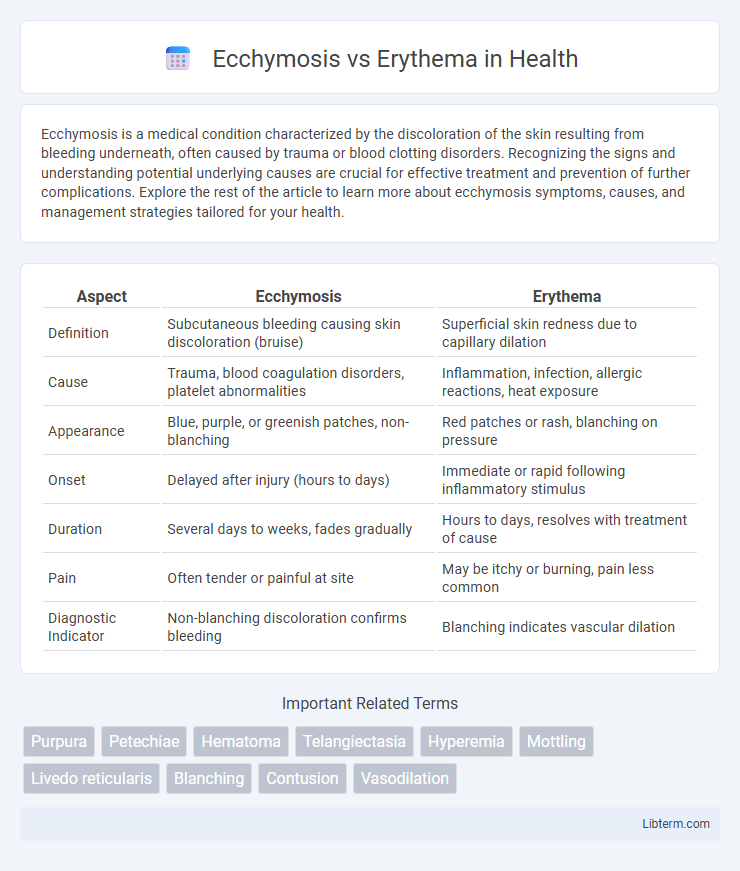Ecchymosis is a medical condition characterized by the discoloration of the skin resulting from bleeding underneath, often caused by trauma or blood clotting disorders. Recognizing the signs and understanding potential underlying causes are crucial for effective treatment and prevention of further complications. Explore the rest of the article to learn more about ecchymosis symptoms, causes, and management strategies tailored for your health.
Table of Comparison
| Aspect | Ecchymosis | Erythema |
|---|---|---|
| Definition | Subcutaneous bleeding causing skin discoloration (bruise) | Superficial skin redness due to capillary dilation |
| Cause | Trauma, blood coagulation disorders, platelet abnormalities | Inflammation, infection, allergic reactions, heat exposure |
| Appearance | Blue, purple, or greenish patches, non-blanching | Red patches or rash, blanching on pressure |
| Onset | Delayed after injury (hours to days) | Immediate or rapid following inflammatory stimulus |
| Duration | Several days to weeks, fades gradually | Hours to days, resolves with treatment of cause |
| Pain | Often tender or painful at site | May be itchy or burning, pain less common |
| Diagnostic Indicator | Non-blanching discoloration confirms bleeding | Blanching indicates vascular dilation |
Understanding Ecchymosis and Erythema
Ecchymosis is a medical condition characterized by subcutaneous bleeding that results in a blue or purple discoloration of the skin, commonly known as bruising, caused by trauma or vascular fragility. Erythema involves redness of the skin due to increased blood flow in superficial capillaries, often triggered by inflammation, infection, or allergic reactions. Differentiating between ecchymosis and erythema is crucial in clinical diagnosis, as ecchymosis indicates bleeding beneath the skin, while erythema signifies vascular dilation or inflammatory response.
Definition and Key Differences
Ecchymosis refers to a large, subcutaneous bruise caused by blood escaping from ruptured blood vessels, resulting in a blue or purple discoloration on the skin. Erythema is characterized by redness of the skin due to increased blood flow in superficial capillaries, often indicating inflammation or infection. The key difference lies in ecchymosis being a result of bleeding under the skin, whereas erythema is caused by vascular dilation and increased blood volume without bleeding.
Causes of Ecchymosis
Ecchymosis occurs due to trauma or injury causing blood vessels to rupture and blood to leak into surrounding tissues, resulting in visible bruising. Other causes include bleeding disorders such as hemophilia, platelet deficiencies, or anticoagulant medications that impair normal clotting mechanisms. Systemic conditions like vitamin K deficiency, liver disease, or vasculitis can also contribute to the development of ecchymosis.
Causes of Erythema
Erythema is primarily caused by increased blood flow to the superficial capillaries of the skin, often due to inflammation, infection, or allergic reactions. Common triggers include sun exposure, skin irritation from chemicals or allergens, and systemic conditions such as rosacea or lupus. Unlike ecchymosis, which results from bleeding under the skin, erythema reflects vascular dilation without blood leakage.
Clinical Presentation: Signs and Symptoms
Ecchymosis presents clinically as a bluish-purple or greenish discoloration of the skin caused by blood leakage into the subcutaneous tissues, often resulting from trauma and appearing as a flat bruise without surface redness. Erythema manifests as localized redness due to capillary dilation, commonly accompanied by warmth, swelling, and occasional tenderness, indicating inflammation or infection. Differentiating between ecchymosis and erythema relies on color, texture, and associated symptoms such as pain or induration.
Diagnostic Approaches
Ecchymosis is diagnosed primarily through physical examination revealing a purplish discoloration caused by subcutaneous bleeding, often confirmed with patient history and coagulation tests to identify bleeding disorders. Erythema is identified by redness of the skin due to increased blood flow, assessed visually and sometimes with tools like dermoscopy or infrared imaging to evaluate inflammation or infection. Differential diagnosis relies on distinguishing color intensity, border patterns, and associated symptoms such as pain or swelling, supported by laboratory tests and imaging when necessary.
Underlying Medical Conditions
Ecchymosis is typically linked to underlying conditions such as coagulation disorders, platelet abnormalities, or trauma, indicating bleeding beneath the skin, whereas erythema commonly signals inflammation or infection due to conditions like cellulitis, dermatitis, or autoimmune reactions. Ecchymosis often arises in patients with hemophilia, thrombocytopenia, or anticoagulant therapy, reflecting vascular or hematologic dysfunction. Erythema is frequently observed in inflammatory diseases such as lupus, rosacea, and allergic reactions, emphasizing its role as a marker of skin irritation and immune response.
Treatment and Management Strategies
Ecchymosis requires cold compresses initially to reduce bleeding and swelling, followed by warm compresses to promote reabsorption of blood under the skin, with pain management often involving NSAIDs. Erythema treatment depends on the underlying cause; for inflammatory or allergic reactions, corticosteroids and antihistamines are commonly prescribed, while infections necessitate appropriate antibiotics or antifungals. Both conditions benefit from monitoring and avoiding aggravating factors to prevent progression or secondary complications.
Prognosis and Complications
Ecchymosis typically resolves without complications, with full recovery expected within two weeks as the body reabsorbs the pooled blood under the skin, while erythema often indicates inflammation or infection, requiring prompt treatment to prevent progression to more severe conditions such as cellulitis or chronic dermatitis. Prognosis for ecchymosis is generally excellent unless associated with underlying bleeding disorders, whereas erythema's prognosis depends on identifying and managing the causative factors to avoid skin damage or systemic involvement. Complications in erythema may include persistent redness, skin ulceration, or scarring if untreated, contrasting with the transient discoloration seen in uncomplicated ecchymosis.
When to Seek Medical Attention
Ecchymosis typically appears as a large bruise caused by bleeding under the skin, while erythema presents as redness due to increased blood flow or inflammation. Seek medical attention for ecchymosis if bruising occurs without injury, spreads rapidly, or is accompanied by severe pain or swelling, as these may indicate bleeding disorders or infections. For erythema, consult a healthcare provider if redness is persistent, worsening, accompanied by fever, or shows signs of infection such as pus or warmth.
Ecchymosis Infographic

 libterm.com
libterm.com